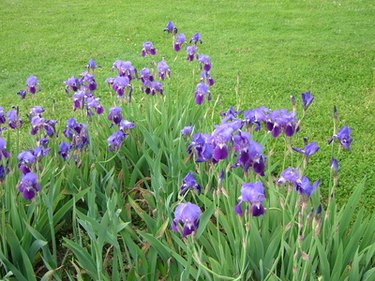Things You'll Need
Pruning shears or sharp scissors
Clean paintbrush or soft rag
Powdered sulfur garden soil amendment
Breathable container

Irises are cold, hardy flowering plants. Their bulbs, technically known as rhizomes, can be dug and stored if needed for transplanting or to take them with you on a move. Though they rarely if ever require out of ground storage, for some species of iris, the rhizomes may need to be overwintered in a protected location in USDA climate Zone 3 or below, or where winter temperatures regularly drop below -35 degrees Fahrenheit, according to North Dakota State University. Careful digging, cleaning and storage practices will ensure healthy growth and bloom performance once the bulbs are transplanted back into the garden soil.
Step 1
Pull your iris bulbs from the soil only after all of the foliage has naturally and completely died back, in the summer or fall, allowing the plant nutrients to relocate down to the rhizome. Transfer of nutrients back into the rhizome or bulb greatly improves its chances of vigorous growth and bloom in future seasons.
Video of the Day
Step 2
Cut off the dead foliage tops and compost or discard them. Throw away any bulbs that appear diseased, are mushy-soft with rot or have a significant coating of mold or mildew.
Step 3
Gently brush or wipe away any clumps or significant encrustations of dirt from the rhizome with a dry clean brush or cloth. Do not wash or rinse your iris rhizomes to remove dirt; keep them dry. Do not remove any of the skin of the rhizome nor attempt to remove every speck of dirt, as it is not necessary.
Step 4
Dust the cleaned, dry rhizomes with a thin coat of powdery, ground sulfur garden amendment. North Dakota State University recommends this to prevent bulb rot and deter insect feeding during storage.
Step 5
Nestle the rhizomes loosely into an breathable container such as a wire or wicker basket, wood crate, net or canvas bag or similar holding bin. Do not seal the rhizomes into plastic bags, containers or storage bins.
Step 6
Place the rhizomes in a low-light and dry location where ambient temperatures consistently remain well below 40 degrees Fahrenheit. Any temperatures of 40 degrees or higher will disrupt the cold period and either delay or prevent bloom. Iris rhizomes require at least 15 weeks of cold reset time in order for healthy growth and flowering to occur.
Step 7
Plant the iris rhizomes back into the soil as soon as possible. Plant in spring after the ground is no longer frozen or in the summer or early fall. Do not plant in winter when the ground is hard and frozen; wait until spring.
Video of the Day